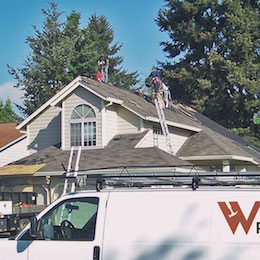Your roofing system is the first line of defense against the elements, providing more protection for your home than any other part of the home. Problems with your roof could lead to major water damage throughout the home (including mold and mildew) and make your house less energy-efficient.
It’s not something we really think about, though. Fortunately, roofing materials today are stronger and more durable than ever before. Three-tab shingles and their short lifespans have been replaced with more robust composite or asphalt shingle roofs, the most common material.
However, when it is time for a new roof, either to prevent leaks or as part of a home remodel, there are a few directions you can take. When it’s time for a new roof, we opt for a roof replacement because of damage or because the roof has just reached the end of its lifespan.
But if the roof is still in decent shape, you might want to consider reroofing or a roof overlay. This is the process of adding a new layer of roofing material over the existing shingles. This isn’t always a viable option for a few reasons, including the types of roofing materials and the condition of the roof.
Why reroofing?
 A new roof provides an immediate upgrade visually, especially if you decide to go with a new design or color of roofing material. And if the existing roof is still in good condition, you may be able to place new roofing over the existing material. This is a much faster process because you don’t need to worry about removing the old roofing material.
A new roof provides an immediate upgrade visually, especially if you decide to go with a new design or color of roofing material. And if the existing roof is still in good condition, you may be able to place new roofing over the existing material. This is a much faster process because you don’t need to worry about removing the old roofing material.
Reroofing is the same installation process, but instead of attaching new materials to the roof deck, you’ll install a layer of shingles on top of the old roof. You don’t have to worry about removing and hauling away the old material, which can be a real timesaver.
Reroofing costs
It’s also a more cost-effective solution, too. You save on time and labor, not paying for the tear-off and hauling away the old material as you do with a roof replacement. All you really need to pay for is the new material and the labor to install it. Financially speaking, it’s an inexpensive, quick, and easy process that provides immediate dividends in appearance and curb appeal.
When it finally comes time to replace the roof, you’ll spend more money in the long run because you’ll have twice as many roof shingles to get rid of. It’s best to think about a reroof as a short-term solution rather than a fix you’ll be happy with for the decades to come.
Reroof vs roof replacement
While the difference in roofing cost should always be a consideration, it shouldn’t be the only factor when it comes time to make a decision. In some cases, a reroof isn’t possible because of the condition of the existing roof. It’s important to get a thorough inspection of your roof before making a decision either way.
If your roof does show signs of damage, the best way to prevent further damage is to go with a roof replacement. Covering up existing issues won’t solve the problem–you’ll just be disguising the problem. Reputable roofers won’t even offer a reroof unless the existing roofing system is already in pretty good shape.
Is reroofing an option for me?
One thing to consider when choosing between an overlay/reroof or a total roof replacement is the type of materials you want and what your current roof is made of. Certain materials just don’t mesh: You wouldn’t cover a clay roof with metal roofs because of the installation process.
Nailing or screwing the new material into place would wreak havoc on the tiles below, causing more problems than if you just left everything alone. Weight is also a concern–slate tiles are incredibly heaving and often need more structural support than many homes already have.
But if you want to put shingles over shingles, your home could be a good candidate for reroofing. As we’ve said before, this is a good solution to fix up a rental or perhaps get a house ready to sell. In either case, it won’t fix issues you already have–a reroof will only hide them.
